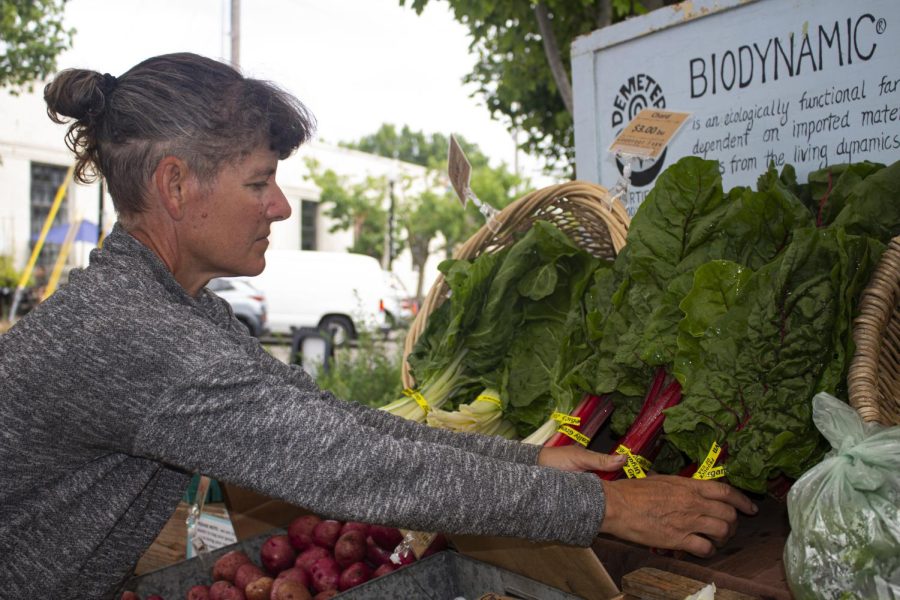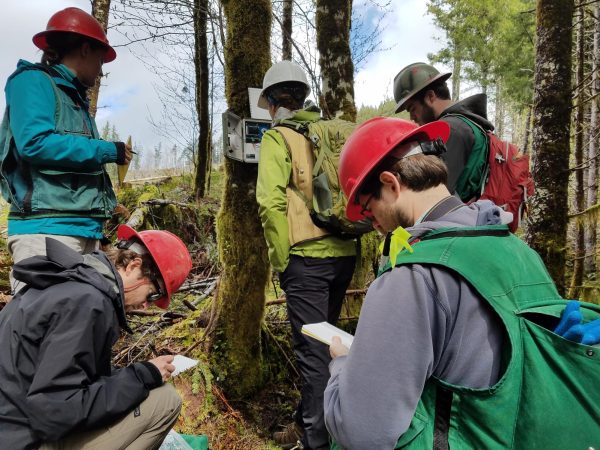Abnormal spring weather leads to shortages at Corvallis Farmers’ Market
Farmer Beth Hoinacki of GoodFoot Farm takes stock and inventory of organic produce on July 16 at the Farmers’ Market in Corvallis, Ore. GoodFoot Farm is certified in biodynamic and organic farming practices and is self-labeled as a diversified market farm.
August 1, 2022
Following an unusually wet and cold spring, signs throughout the Corvallis Farmers’ Market warn of possible delays and shortages in produce.
Many vendors described difficulties adjusting to the unpredictable weather experienced throughout the Willamette Valley. For Chad Shinn, owner of Camron Ridge Farmstead, the constant rain and cold temperatures of earlier this year made it extremely difficult to plant certain crops on time.
“Really the rain affects our succession planning,” Shinn said. “Succession planning for us, like you know we’re gonna plant beets every three weeks. We might miss one. We might miss two. So there’s going to be a gap.”
Fluctuations in spring temperature led to crop waste for some farmers. According to Corvallis Farmers’ Market Manager Aurora Ashkar, the heat in early spring led to flowering, which was then disrupted when temperatures plummeted back down into the 30 degree Fahrenheit range.
Beth Hoinacki, owner of Goodfoot Farm, experienced similar losses in her own fields due to the weather.
“It’s definitely reduced our early season crops,” Hoinacki said. “We weren’t able to get into the fields when we typically do, and so a lot of the work that we do early in the season like starting plants in our propagation house, those had to be tossed out because we didn’t have ground to plant them in, for example.”
Though the wet spring took a toll on many of the vendors at Corvallis Farmers’ Market, they were still able to adapt to or even benefit from the unique situation.
Tal Singh, co-owner of Riverland Family Farms, is one such farmer. According to Singh, this year has been positive compared to the previous one, as his tomato plants suffered in 2021’s heat wave.
Singh greatly benefited from having 12 out of 20 acres of his farm covered by hoop houses, also known as high tunnels. These structures protected his crops from the harsh rain and cold weather outside.
Using high tunnels to combat weather conditions was a common trend among farmers at the market. Shinn attributed the use of high tunnels to saving his farm’s early season.
“We’re probably a month and a half behind with the growing season for us because we’re just really a small family farm,” Shinn said. “We have a couple of high tunnels; you know, without the high tunnels we would basically not have any kind of revenue at the beginning of the year. We’re actually just now starting our year where usually we would have been here in May as far as the volume that we would normally have.”
For Hoinacki at Goodfoot Farm, growing a variety of crops that can survive in different conditions helped mitigate weather-related losses.
“We try to balance that [the losses] by being diversified so it’s not just one piece,” Hoinacki said. “For example, with our tree fruit orchard, we won’t have any plums or Asian pears this year due to late spring freezes, but we will have apples. Because we don’t depend on any one thing for our season’s overall revenue, it all works.”
Outside help was also a factor in getting farms where they needed to be this season.
Ashkar and berry harvesting intern Elliot Scheuer both gave a shout out to the Oregon State University students who assisted them.
“We had a lot of really great volunteer help at the end of spring term and beginning of summer,”Ashkar said. “Once things started to dry out to get that push of getting everything in the ground and getting us back on track for the rest of the season thanks to students.”
Though 2022’s growing season has brought up various difficulties so far, farmers like Hoinacki are cautiously optimistic moving into the heat of summer.
“It seems like we’ve slipped into our predictable Oregon summer, but that could change,” Hoinacki said. “I think the feeling is that it’s just been all over the place, and who knows? Right at this moment it feels like it’s where it’s supposed to be, but we also kind of feel like we could have a terrible fire season like we did a couple years ago.”
The Corvallis Farmers’ Market on First Street is open from 9 a.m. to 1 p.m. on Wednesdays and Saturdays through Nov. 23.
























































































































